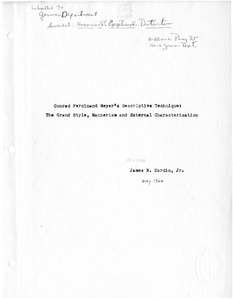| dc.description.abstract | In these four works description of fictional personalities and the settings in which the author places them is very important, much more so, in fact, than in the works of most writers. There are several reasons for this, two of which are suggested in the title of this paper, that is, the "'grand style" and external characterization. The very useful term, "grand style," I borrow from Arthur Burkhard1s critical work, Conrad Ferdinand Meyer: The Style and the Man. Burkhard believes that Meyer was striving consciously for a striking, unusual effect in
his desc riptive technique, an effect which the Swiss poet felt he could best attain through imitation of Renaissance plastic art. Such an imitation requires the artist to emphasize the magnificent, the rich and the universal, requires that he strive to portray the essential, not the incidental, and requires, finally, that he deal with the great and ignore the trivial. Meyer attempts to accomplish this in his work, and the style he employs to do so Mr. Burkhard designates, fittingly I believe, the "grand style." As we will see in the following pages, Meyer had an artistic ideal, and a part of that ideal was to describe his characters and settings in the grand manner. Because the effort to do so was a conscious one we find in his works descriptions which, in their striking beauty and quality of richness, are something more than conventional pictorial representations of reality. Rather, they are impressive examples of Meyer's highest artistic achievement, the synthesis of noble, heroic subject matter with a stately prose style. Thus, the striving for a grand style is one reason for the great
importance of the descriptive technique in Meyer's prose work. The second reason, mentioned previously, is what I call "exterior characterization." I mean by this simplified term revelation of character, emotion and state of mind through description of the external, physical appearance of the fictional figure concerned. Meyer, for reasons which will be discussed later, prefers to explain his characters in this way rather than by divulging their thoughts to the reader directly. Obviously this principle places a great burden on descriptive methods as well as the artist, and it is the second reason for the importance of Meyer's descriptive technique. [From Introduction] | en_US |
| dc.rights | This material is made available for use in research, teaching, and private study, pursuant to U.S. Copyright law. The user assumes full responsibility for any use of the materials, including but not limited to, infringement of copyright and publication rights of reproduced materials. Any materials used should be fully credited with the source. | en_US |
